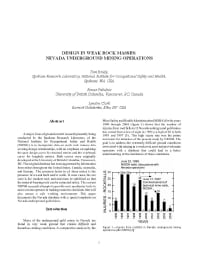Mining Publication: Design in Weak Rock Masses: Nevada Underground Mining Operations
Original creation date: February 2005
Authors: TM Brady, R Pakalnis, L Clark
NIOSHTIC2 Number: 20030429
2005 SME Annual Meeting, February 28 - March 2, Salt Lake City, Utah, preprint 05-43. Littleton, CO, Society for Mining, Metallurgy, and Exploration, Inc., 2005 Feb; :1-9
A major focus of ground control research presently being conducted by the Spokane Research Laboratory of the National Institute for Occupational Safety and Health (NIOSH) is to incorporate data on weak rock masses into existing design relationships, with an emphasis on updating the span design curve for manned entries and the overbreak curve for longhole entries. Both curves were originally developed at the University of British Columbia, Vancouver, BC. The original database has been augmented by information from mines throughout the United States, Canada, Australia, and Europe. The common factor in all of these mines is the presence of a weak back and/or walls. In most cases, the ore zone is the weakest rock unit and must be stabilized so that the mineral-bearing rock can be extracted safety. The current NIOSH research attempts to provide rock mechanics tools to assist a mine operator in making economic decisions that will also ensure a safe working environment. This paper documents the Nevada database with a special emphasis on Nevada underground gold mines.

NIOSHTIC2 Number: 20030429
2005 SME Annual Meeting, February 28 - March 2, Salt Lake City, Utah, preprint 05-43. Littleton, CO, Society for Mining, Metallurgy, and Exploration, Inc., 2005 Feb; :1-9